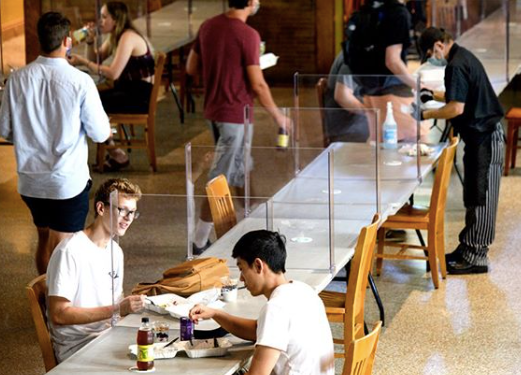
Students eat out of to-go containers in Commons Dining Hall — photo courtesy of Hamilton College
During a typical Hamilton meal time, one might make a self-serve salad, grab a slice of pizza, or use the soda machine. Eating with metal silverware off a ceramic plate while engrossed in conversation with friends, mealtime was for some, a break from academic life.
With COVID taking over our lives, these otherwise familiar rituals are not the same. Hamilton College has worked hard in order to comply with state health regulations, which have transformed how mealtime operates. The New York State Education Department (NYSED) guidelines decree that schools must
“Update standard operating procedures for sanitation of school kitchens, cafeterias, food warehouses, and central production kitchens.”
These updates include adding barriers,
“removing the use of shared tables, salad bars, and other self-service refrigerators and buffets for food and condiments,”
among others. These mandates create more social distance and less opportunity for the spread of germs in high-traffic areas like the dining hall.
Beginning this August, walking into a dining hall, students must wait in line six-feet apart as indicated by large stickers on the ground and wait to be served by dining staff behind plastic barriers. Each meal is served in a take-away container and eaten with plastic silverware. Baked goods, fruit, salads, cereal, etc., all foods that were traditionally self-serve items, are now wrapped individually in plastic. While these protocols are most optimal for a quick, contact-free dining experience, one might consider, what is the environmental toll?
Approximately every student eats three meals a day. If we pretend self-made meals don’t exist for the sake of this argument, that would be around 1,750 people eating 5,250 meals a day. Each time they take silverware, maybe some bottled water, and a plastic to-go container. While these safety measures have been put in place to protect students, staff, and the greater community, is there a better way to go about it? We don’t know.
Keep in mind that this is not just Hamilton. Every college has undergone similar transformations in pursuit of staying open. Additionally, since March, restaurants have primarily been serving their meals in plastic, single-use containers. Many coffee shops and grocery stores have banned the use of reusable mugs and bags. These are definitely the safest and smartest options for preventing the spread of COVID.
In a study done by
The Minnesota Pollution Agency
it was found that after two middle schools (Minnetonka Middle School East and West) — a combined population of approximately 2,564 people — switched from single-use plastic to reusable alternatives, they prevented 6,712 pounds of trash from ending up in landfills after one school year. They were also able to reduce their greenhouse gas emissions by 77% and combat water consumption by tens of thousands of gallons. Obviously, this happened before COVID. Before COVID, Hamilton too was taking measures to reduce their environmental impact.
COVID seems to have stopped the school’s environmental path dead in its tracks. As students flock to the dining hall day after day, we encourage them to perhaps bring reusable silverware or buy a water bottle to limit individual use of plastic.
Climate change and COVID-19 are two massively scary epidemics occurring at the same time. And maybe preventative measures to halt the damaging effects of the two epidemics are mutually exclusive. We are not weighing the extremity of COVID-19 vs. climate change. The two are inextricably tied together and it is unclear how to handle one without harming the other.